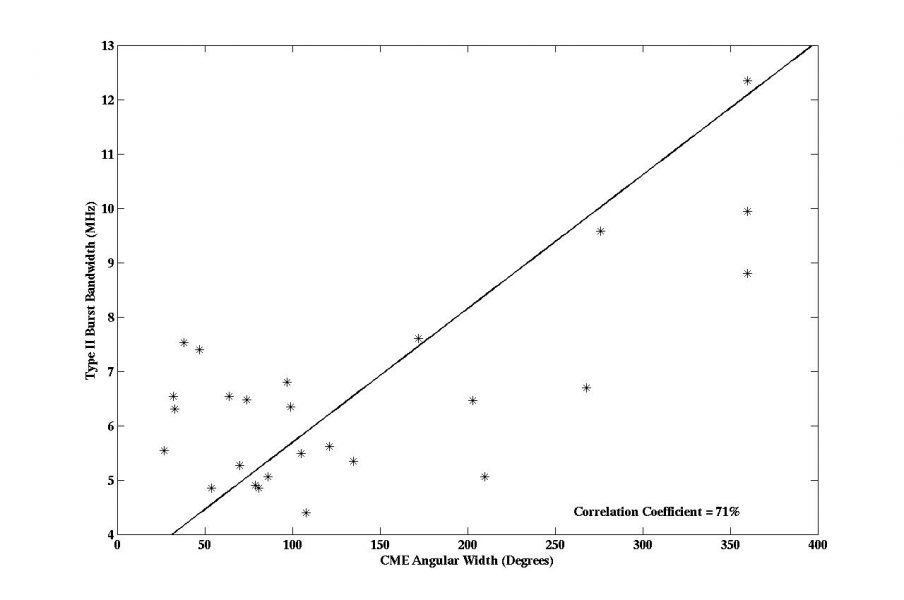While it is widely accepted that the type II radio bursts observed in the interplanetary medium are due to the coronal mass ejections (CMEs), the energetic disturbance responsible for the shocks that generate the type II bursts observed in the near-Sun corona is still being debated. Several studies indicate that CMEs are responsible for the coronal type II bursts too, but flares and various other eruptive activity have also been reported as drivers of the shocks that generate these bursts. Therefore, any result that independently constrains the shock driver of the near-Sun type II bursts would be useful and important. In this connection we compared the instantaneous bandwidth of the coronal type II bursts and the angular width of the associated CMEs. We carried out a statistical study of twenty six type II radio bursts from the Sun observed with the Gauribidanur LOw-frequency Solar Spectrograph (GLOSS) in the frequency range 85 – 35 MHz during the period 2009 – 2019. For information on the CMEs, we used the catalog generated from observations with the Large Angle and Spectrometric Coronagraph C2 (LASCO C2) on board the SOlar and Heliospheric Observatory (SOHO).

Figure 1 – Bandwidth of the type II bursts observed with the GLOSS versus the angular width of the associated CMEs. The straight line is the linear least squares fit to the data points.
Analysis and Results:
Figure 1 indicates a significant correlation (~71%) between the bandwidth of the type II bursts and the angular width of the associated CMEs. Both the above quantities are directly measurable from the respective observations (i.e. radio and white light) without any assumptions. This suggests that the type II bursts in our data set are likely due to shocks driven by the associated CMEs. The different locations from the nose to the flanks of the shock will be at different heliocentric distances. Therefore the electron density (and hence plasma frequency) at the respective locations will be different. It was reported recently that type II radio emission occurs at locations where the shock is super-critical with quasi-perpendicular geometry (Jebaraj et al., 2021; Kouloumvakos et al. 2021). These conditions can be unique to different parts of the shock. Note that a shock is said to be quasi-perpendicular if the angle between the shock normal and the upstream magnetic field is >45 degrees. The critical Alfven-Mach number for such a shock is typically in the range ~1.1 – 2.8 depending on the local plasma parameters (Benz & Thejappa 1988; Mann et al., 1995). Shocks whose Alfven-Mach number exceeds the critical Alfven-Mach number corresponding to that particular location are said to be super-critical. Reports indicate that the shock geometry in the low corona could be quasi-perpendicular at several regions on the shock (Gopalswamy et al. 2012), and sub-critical quasi-perpendicular shocks could also generate coronal type II bursts (Mann et al., 1995). Assuming that all of the aforementioned conditions are favorable for the generation of type II emission, it is very likely that they would be satisfied at multiple locations or along an extended region on the shock. Multi-frequency radio imaging data show that the centroids of the type II bursts observed at different frequencies at the same time are laterally displaced (Kouloumvakos et al., 2021) This suggests co-temporal occurrence of the type II radio bursts from an extended region with different electron density, and hence plasma frequency values, on the shock ahead of a CME. There are reports of modeling of type II burst dynamic spectra assuming parabola shaped global shock with multiple electron acceleration regions with quasi-perpendicular geometry (Knock & Cairns 2005). The correlation between average instantaneous bandwidths of type II bursts and angular widths of the associated CMEs in the present case is consistent with these results.
Conclusions:
We analyzed twenty six low frequency (85 – 35 MHz) type II solar radio bursts observed with the GLOSS during the period 2009 – 2019, along with the associated CMEs and flares. It is found that the average instantaneous bandwidth of the bursts correlate well with the angular width of the CMEs. The correlation coefficient is ~71%. This indicates that: (i) the coronal type II bursts reported in the present work are most likely due to shocks driven by the CMEs, and (ii) the acceleration of electrons leading to the bursts occurs simultaneously at multiple locations or over an extended region on the shock which in turn has a bearing on the instantaneous bandwidth of the bursts.
Based on a recently published article: R. Ramesh, C. Kathiravan, and S. Surya Natarajan (2022). New Results from the Spectral Observations of Solar Coronal Type II Radio Bursts, Astrophysical Journal, 926, 38 DOI: 10.3847/1538-4357/ac4bd6
References:
Benz, A. O., & Thejappa, G., 1988, Astron. Astrophys., 202, 267
Gopalswamy, N., Nitta, N. Akiyama, S. Makela, P., & Yashiro, S., 2012, Astrophys. J., 744, 72
Jebaraj, I. C., Kouloumvakos, A., Magdalenic, J., et al., 2021, Astron. Astrophys., 654, A64
Knock, S. A., & Cairns, I. H., 2005, J. Geophys. Res., 110, A01101
Kouloumvakos, A., Rouillard, A., Warmuth, A., et al., 2021, Astrophys. J., 913, 99
Mann, G., Classen, T., & Aurass, H., 1995, Astron. Astrophys., 295, 775
*Full list of authors: R. Ramesh. C. Kathiravan, and S. Surya Natarajan
